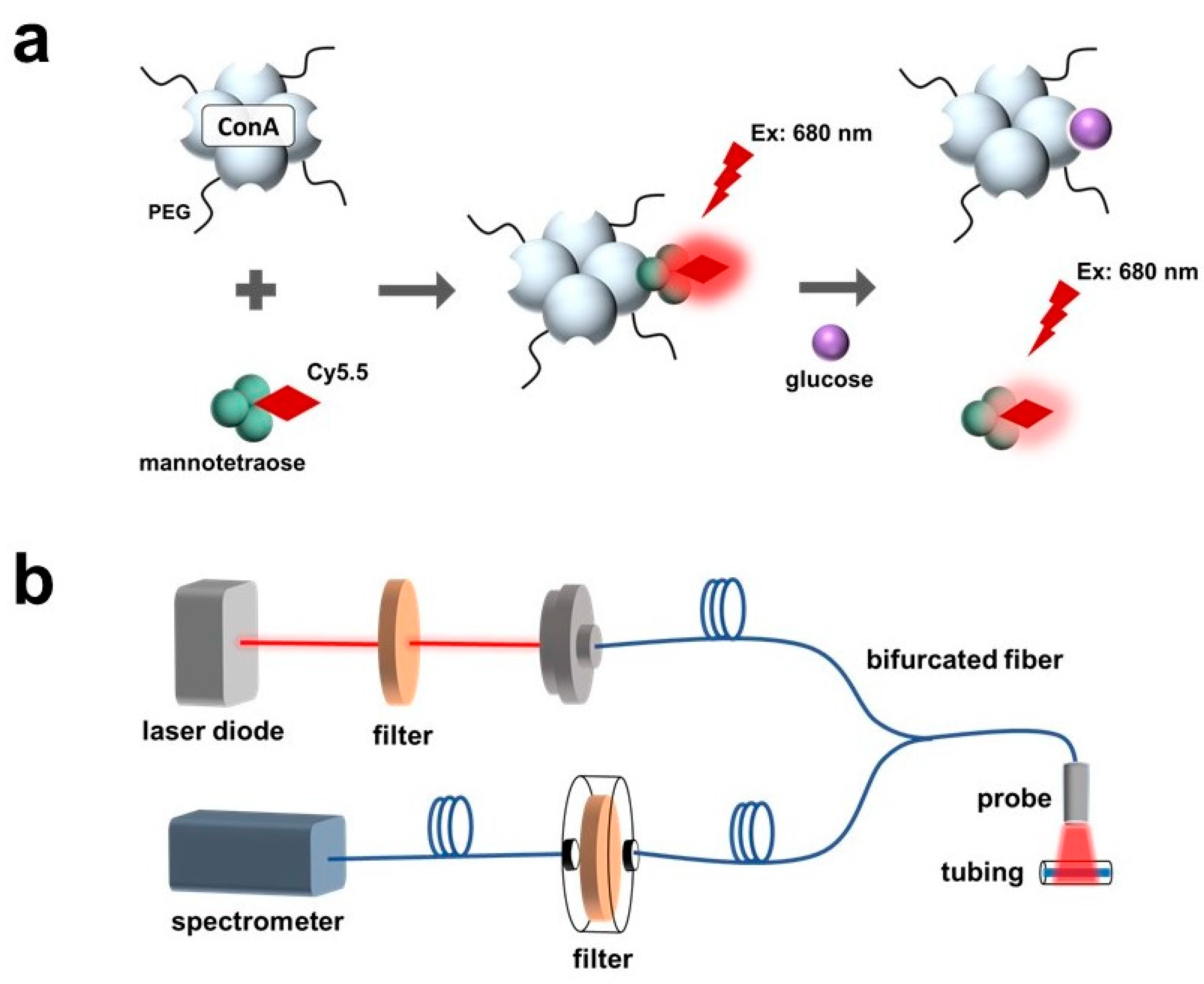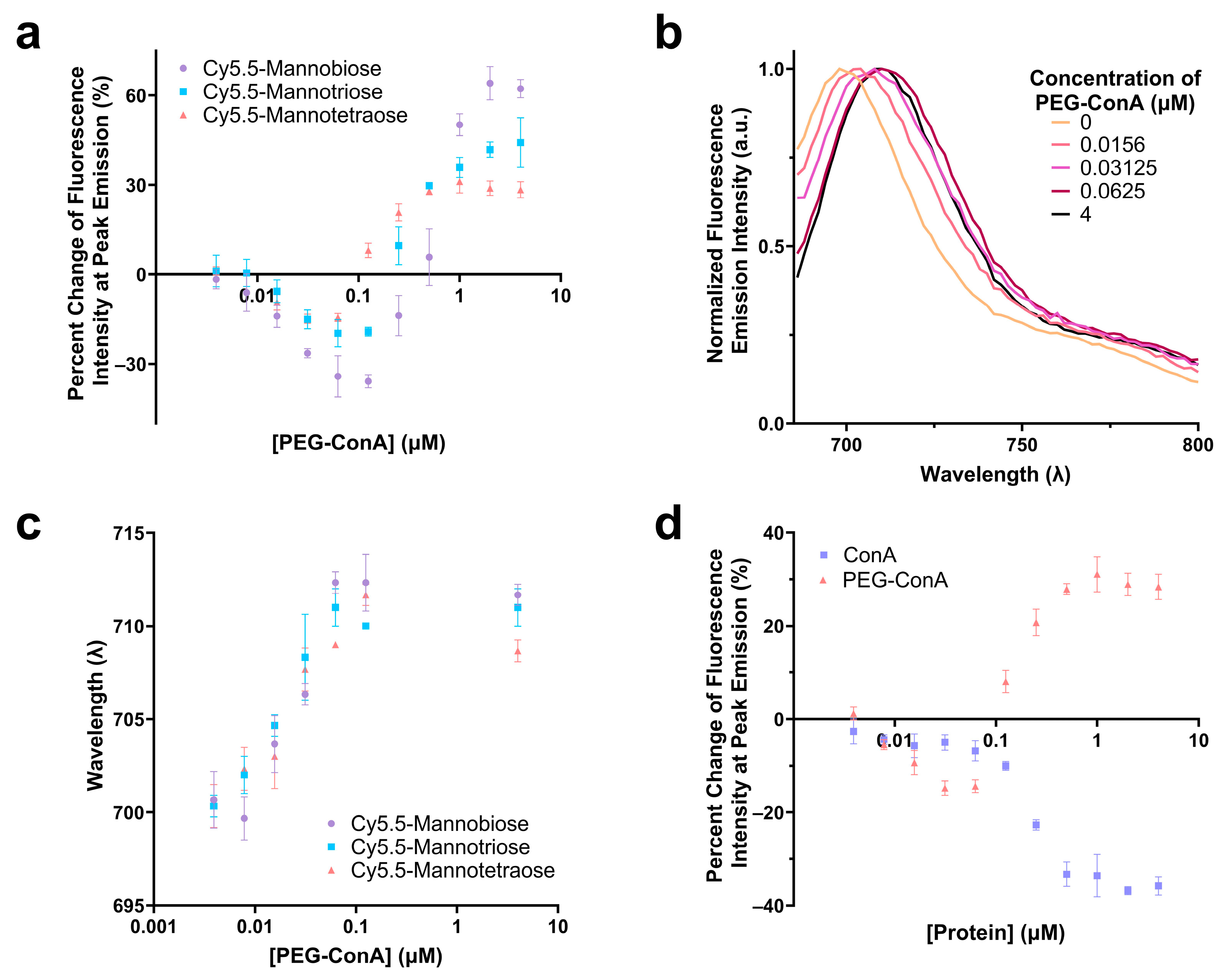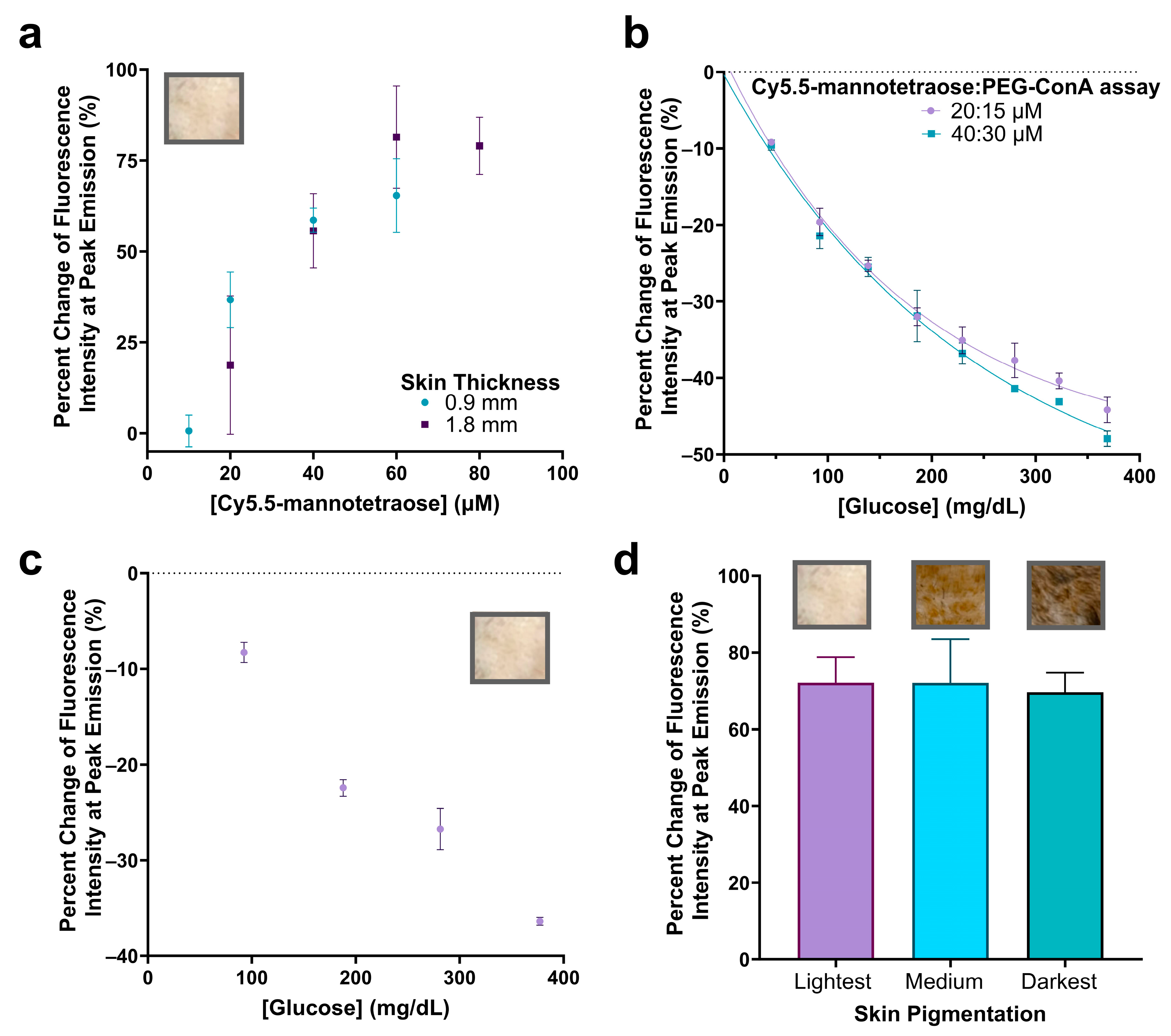A Polarity-Sensitive Far-Red Fluorescent Probe for Glucose Sensing through Skin
Abstract
1. Introduction
2. Materials and Methods
2.1. Materials and Instrumentation
2.2. Synthesis of Cy5.5-Mannose and PEG-ConA
2.3. Binding Studies of PEG-ConA and Cy5.5-Mannose
2.4. Characterization of the Effect of Solvents on the Cy5.5-Mannose
2.5. Optimization of Glucose Sensing
2.6. Glucose Sensing through Skin
3. Results
3.1. Binding Studies of PEG-ConA and Cy5.5-Mannose
3.2. Characterization of the Effect of Solvents on the Cy5.5-Mannose
3.3. Optimization of Glucose Sensing
3.4. Glucose Sensing through Skin
4. Conclusions
Supplementary Materials
Author Contributions
Funding
Data Availability Statement
Acknowledgments
Conflicts of Interest
References
- Johnston, L.; Wang, G.L.; Hu, K.H.; Qian, C.E.; Liu, G.Z. Advances in Biosensors for Continuous Glucose Monitoring Towards Wearables. Front. Bioeng. Biotechnol. 2021, 9, 733810. [Google Scholar] [CrossRef]
- Sun, H.; Saeedi, P.; Karuranga, S.; Pinkepank, M.; Ogurtsova, K.; Duncan, B.B.; Stein, C.; Basit, A.; Chan, J.C.; Mbanya, J.C. IDF Diabetes Atlas: Global, regional and country-level diabetes prevalence estimates for 2021 and projections for 2045. Diabetes Res. Clin. Pract. 2022, 183, 109119. [Google Scholar] [CrossRef]
- Xue, Y.; Thalmayer, A.S.; Zeising, S.; Fischer, G.; Lübke, M. Commercial and Scientific Solutions for Blood Glucose Monitoring—A Review. Sensors 2022, 22, 425. [Google Scholar] [CrossRef]
- Heo, Y.J.; Kim, S.-H. Toward long-term implantable glucose biosensors for clinical use. Appl. Sci. 2019, 9, 2158. [Google Scholar] [CrossRef]
- Jernelv, I.L.; Milenko, K.; Fuglerud, S.S.; Hjelme, D.R.; Ellingsen, R.; Aksnes, A. A review of optical methods for continuous glucose monitoring. Appl. Spectrosc. Rev. 2019, 54, 543–572. [Google Scholar] [CrossRef]
- Abbott. CGM Leader Poised for More Growth. Available online: https://www.abbott.com/corpnewsroom/strategy-and-strength/cgm-leader-poised-for-more-growth.html (accessed on 30 September 2022).
- Yu, Z.Y.; Jiang, N.; Kazarian, S.G.; Tasoglu, S.; Yetisen, A.K. Optical sensors for continuous glucose monitoring. Prog. Biomed. Eng. 2021, 3, 022004. [Google Scholar] [CrossRef]
- Mian, Z.; Hermayer, K.L.; Jenkins, A. Continuous glucose monitoring: Review of an innovation in diabetes management. Am. J. Med. Sci. 2019, 358, 332–339. [Google Scholar] [CrossRef]
- Sabu, C.; Henna, T.K.; Raphey, V.R.; Nivitha, K.P.; Pramod, K. Advanced biosensors for glucose and insulin. Biosens. Bioelectron. 2019, 141, 111201. [Google Scholar] [CrossRef]
- Peng, Z.; Xie, X.; Tan, Q.; Kang, H.; Cui, J.; Zhang, X.; Li, W.; Feng, G. Blood glucose sensors and recent advances: A review. J. Innov. Opt. Health Sci. 2022, 15, 2230003. [Google Scholar] [CrossRef]
- Ahmad Tarar, A.; Mohammad, U.; Srivastava, S.K. Wearable skin sensors and their challenges: A review of transdermal, optical, and mechanical sensors. Biosensors 2020, 10, 56. [Google Scholar] [CrossRef]
- Souza-Barros, L.; Dhaidan, G.; Maunula, M.; Solomon, V.; Gabison, S.; Lilge, L.; Nussbaum, E.L. Skin color and tissue thickness effects on transmittance, reflectance, and skin temperature when using 635 and 808 nm lasers in low intensity therapeutics. Lasers Surg. Med. 2018, 50, 291–301. [Google Scholar] [CrossRef]
- Adamoczky, A.; Nagy, T.; Fehér, P.P.; Pardi-Tóth, V.; Kuki, Á.; Nagy, L.; Zsuga, M.; Kéki, S. Isocyanonaphthol Derivatives: Excited-State Proton Transfer and Solvatochromic Properties. Int. J. Mol. Sci. 2022, 23, 7250. [Google Scholar] [CrossRef]
- Pickup, J.C.; Hussain, F.; Evans, N.D.; Rolinski, O.J.; Birch, D.J. Fluorescence-based glucose sensors. Biosens. Bioelectron. 2005, 20, 2555–2565. [Google Scholar] [CrossRef]
- Esteoulle, L.; Daubeuf, F.; Collot, M.; Riché, S.; Durroux, T.; Brasse, D.; Marchand, P.; Karpenko, I.A.; Klymchenko, A.S.; Bonnet, D. A near-infrared fluorogenic dimer enables background-free imaging of endogenous GPCRs in living mice. Chem. Sci. 2020, 11, 6824–6829. [Google Scholar] [CrossRef]
- Homocianu, M. Optical properties of solute molecules: Environmental effects, challenges, and their practical implications. Microchem. J. 2021, 161, 105797. [Google Scholar] [CrossRef]
- Parasassi, T.; Krasnowska, E.K.; Bagatolli, L.; Gratton, E. Laurdan and Prodan as polarity-sensitive fluorescent membrane probes. J. Fluoresc. 1998, 8, 365–373. [Google Scholar] [CrossRef]
- Qian, M.; Zhang, L.; Pu, Z.; Zhang, C.; Chen, Q.; Sui, X.; Han, X.; Zeng, S.; Cui, H.; Wang, J. A mitochondria-targeting and polarity-sensitive fluorescent probe for cancer diagnosis. Sens. Actuators B Chem. 2021, 344, 130261. [Google Scholar] [CrossRef]
- Yao, D.; Lin, Z.; Wu, J. Near-infrared fluorogenic probes with polarity-sensitive emission for in vivo imaging of an ovarian cancer biomarker. ACS Appl. Mater. Interfaces 2016, 8, 5847–5856. [Google Scholar] [CrossRef]
- Klonoff, D.C. Overview of fluorescence glucose sensing: A technology with a bright future. J. Diabetes Sci. Technol. 2012, 6, 1242–1250. [Google Scholar] [CrossRef]
- Cavada, B.S.; Osterne, V.J.S.; Lossio, C.F.; Pinto-Junior, V.R.; Oliveira, M.V.; Silva, M.T.L.; Leal, R.B.; Nascimento, K.S. One century of ConA and 40 years of ConBr research: A structural review. Int. J. Biol. Macromol. 2019, 134, 901–911. [Google Scholar] [CrossRef]
- Hu, Y.; Yang, D.; Zhang, H.; Gao, Y.; Zhang, W.; Yin, R. A High-Linearity Glucose Sensor Based on Silver-Doped Con A Hydrogel and Laser Direct Writing. Polymers 2023, 15, 1423. [Google Scholar] [CrossRef] [PubMed]
- Locke, A.; Cummins, B.; Abraham, A.; Coté, G. Long Term Response of a Concanavalin-A Based Fluorescence Glucose Sensing Assay; SPIE: San Francisco, CA, USA, 2015; Volume 9332. [Google Scholar]
- Olmsted, I.R.; Kussrow, A.; Bornhop, D.J. Comparison of Free-Solution and Surface-Immobilized Molecular Interactions Using a Single Platform. Anal. Chem. 2012, 84, 10817–10822. [Google Scholar] [CrossRef]
- Locke, A.K.; Cummins, B.M.; Abraham, A.A.; Cote, G.L. PEGylation of concanavalin A to improve its stability for an in vivo glucose sensing assay. Anal. Chem. 2014, 86, 9091–9097. [Google Scholar] [CrossRef]
- Ballerstadt, R.; Evans, C.; McNichols, R.; Gowda, A. Concanavalin A for in vivo glucose sensing: A biotoxicity review. Biosens. Bioelectron. 2006, 22, 275–284. [Google Scholar] [CrossRef]
- Cummins, B.M.; Li, M.; Locke, A.K.; Birch, D.J.; Vigh, G.; Coté, G.L. Overcoming the aggregation problem: A new type of fluorescent ligand for ConA-based glucose sensing. Biosens. Bioelectron. 2015, 63, 53–60. [Google Scholar] [CrossRef]
- Locke, A.K.; Cummins, B.M.; Coté, G.L. High affinity mannotetraose as an alternative to dextran in ConA based fluorescent affinity glucose assay due to improved FRET efficiency. ACS Sens. 2016, 1, 584–590. [Google Scholar] [CrossRef]
- Ballerstadt, R.; Gowda, A.; McNichols, R. Fluorescence resonance energy transfer-based near-infrared fluorescence sensor for glucose monitoring. Diabetes Technol. Ther. 2004, 6, 191–200. [Google Scholar] [CrossRef]
- Tolosa, L.; Malak, H.; Raob, G.; Lakowicz, J.R. Optical assay for glucose based on the luminescnence decay time of the long wavelength dye Cy5™. Sens. Actuators B Chem. 1997, 45, 93–99. [Google Scholar] [CrossRef]
- Zhang, C.; Yuan, Y.; Zhang, S.; Wang, Y.; Liu, Z. Biosensing platform based on fluorescence resonance energy transfer from upconverting nanocrystals to graphene oxide. Angew. Chem. Int. Ed. 2011, 50, 6851–6854. [Google Scholar] [CrossRef]
- Khan, F.; Pickup, J.C. Near-infrared fluorescence glucose sensing based on glucose/galactose-binding protein coupled to 651-Blue Oxazine. Biochem. Biophys. Res. Commun. 2013, 438, 488–492. [Google Scholar] [CrossRef]
- Khan, M.R.R.; Khalilian, A.; Kang, S.-W. Fast, highly-sensitive, and wide-dynamic-range interdigitated capacitor glucose biosensor using solvatochromic dye-containing sensing membrane. Sensors 2016, 16, 265. [Google Scholar] [CrossRef]
- Colvin, L. A Red-Excitable, Fluorescence Intensity-Based Glucose Sensing Assay for a Proposed Fully Injectable Biosensor. Unpublished. Doctoral Dissertation, Texas A&M University, College Station, TX, USA, 2023. [Google Scholar]
- Kim, J.B.; Park, K.; Ryu, J.; Lee, J.J.; Lee, M.W.; Cho, H.S.; Nam, H.S.; Park, O.K.; Song, J.W.; Kim, T.S. Intravascular optical imaging of high-risk plaques in vivo by targeting macrophage mannose receptors. Sci. Rep. 2016, 6, 22608. [Google Scholar] [CrossRef] [PubMed]
- Liang, X.; Shang, W.; Chi, C.; Zeng, C.; Wang, K.; Fang, C.; Chen, Q.; Liu, H.; Fan, Y.; Tian, J. Dye-conjugated single-walled carbon nanotubes induce photothermal therapy under the guidance of near-infrared imaging. Cancer Lett. 2016, 383, 243–249. [Google Scholar] [CrossRef] [PubMed]
- Lu, Z.; Huang, F.-Y.; Cao, R.; Tan, G.-H.; Yi, G.; He, N.; Xu, L.; Zhang, L. Intrinsic, cancer cell-selective toxicity of organic photothermal nanoagent: A simple formulation for combined photothermal chemotherapy of cancer. ACS Appl. Mater. Interfaces 2018, 10, 26028–26038. [Google Scholar] [CrossRef]
- Poh, S.; Putt, K.S.; Low, P.S. Folate-targeted dendrimers selectively accumulate at sites of inflammation in mouse models of ulcerative colitis and atherosclerosis. Biomacromolecules 2017, 18, 3082–3088. [Google Scholar] [CrossRef]
- Stock, R.I.; de Melo, C.E.; Schramm, A.D.; Nicoleti, C.R.; Bortoluzzi, A.J.; Heying, R.d.S.; Machado, V.G.; Rezende, M.C. Structure–behavior study of a family of “hybrid cyanine” dyes which exhibit inverted solvatochromism. Phys. Chem. Chem. Phys. 2016, 18, 32256–32265. [Google Scholar] [CrossRef]
- de Melo, C.E.; Nicoleti, C.R.; Ferreira, M.; dos Santos, M.C.; Kreuz, A.; Schneider, F.S.; Oliboni, R.d.S.; Caramori, G.F.; Machado, V.G. Reverse solvatochromism in a family of probes having 2, 6–di–tert–butylphenolate as electron–donor and 4–nitrophenyl as electron–acceptor groups. Dye. Pigment. 2022, 203, 110376. [Google Scholar] [CrossRef]
- Hörber, S.; Hudak, S.; Kächele, M.; Overkamp, D.; Fritsche, A.; Häring, H.-U.; Peter, A.; Heni, M. Unusual high blood glucose in ketoacidosis as first presentation of type 1 diabetes mellitus. Endocrinol. Diabetes Metab. Case Rep. 2018, 2018. [Google Scholar] [CrossRef]
- Liu, J.; Fang, X.; Zhang, Z.; Liu, Z.; Liu, J.; Sun, K.; Yuan, Z.; Yu, J.; Chiu, D.T.; Wu, C. Long-term in vivo glucose monitoring by polymer-dot transducer in an injectable hydrogel implant. Anal. Chem. 2022, 94, 2195–2203. [Google Scholar] [CrossRef]
- Le, L.V.; Chendke, G.S.; Gamsey, S.; Wisniewski, N.; Desai, T.A. Near-Infrared Optical Nanosensors for Continuous Detection of Glucose. J. Diabetes Sci. Technol. 2020, 14, 204–211. [Google Scholar] [CrossRef]
- Dong, P.; Ko, B.S.; Lomeli, K.A.; Clark, E.C.; McShane, M.J.; Grunlan, M.A. A glucose biosensor based on phosphorescence lifetime sensing and a thermoresponsive membrane. Macromol. Rapid Commun. 2022, 43, 2100902. [Google Scholar] [CrossRef] [PubMed]
- Huang, Y.; Luo, Y.; Liu, H.; Lu, X.; Zhao, J.; Lei, Y. A subcutaneously injected SERS nanosensor enabled long-term in vivo glucose tracking. Eng. Sci. 2020, 14, 59–68. [Google Scholar] [CrossRef]
- Garg, S.K.; Liljenquist, D.; Bode, B.; Christiansen, M.P.; Bailey, T.S.; Brazg, R.L.; Denham, D.S.; Chang, A.R.; Akturk, H.K.; Dehennis, A.; et al. Evaluation of Accuracy and Safety of the Next-Generation Up to 180-Day Long-Term Implantable Eversense Continuous Glucose Monitoring System: The PROMISE Study. Diabetes Technol. Ther. 2022, 24, 84–92. [Google Scholar] [CrossRef] [PubMed]






Disclaimer/Publisher’s Note: The statements, opinions and data contained in all publications are solely those of the individual author(s) and contributor(s) and not of MDPI and/or the editor(s). MDPI and/or the editor(s) disclaim responsibility for any injury to people or property resulting from any ideas, methods, instructions or products referred to in the content. |
© 2023 by the authors. Licensee MDPI, Basel, Switzerland. This article is an open access article distributed under the terms and conditions of the Creative Commons Attribution (CC BY) license (https://creativecommons.org/licenses/by/4.0/).
Share and Cite
Colvin, L.; Tu, D.; Dunlap, D.; Rios, A.; Coté, G. A Polarity-Sensitive Far-Red Fluorescent Probe for Glucose Sensing through Skin. Biosensors 2023, 13, 788. https://doi.org/10.3390/bios13080788
Colvin L, Tu D, Dunlap D, Rios A, Coté G. A Polarity-Sensitive Far-Red Fluorescent Probe for Glucose Sensing through Skin. Biosensors. 2023; 13(8):788. https://doi.org/10.3390/bios13080788
Chicago/Turabian StyleColvin, Lydia, Dandan Tu, Darin Dunlap, Alberto Rios, and Gerard Coté. 2023. "A Polarity-Sensitive Far-Red Fluorescent Probe for Glucose Sensing through Skin" Biosensors 13, no. 8: 788. https://doi.org/10.3390/bios13080788
APA StyleColvin, L., Tu, D., Dunlap, D., Rios, A., & Coté, G. (2023). A Polarity-Sensitive Far-Red Fluorescent Probe for Glucose Sensing through Skin. Biosensors, 13(8), 788. https://doi.org/10.3390/bios13080788




